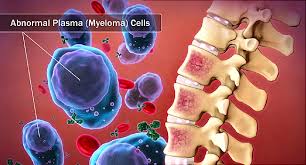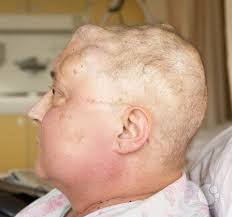
Diagnosed with SMM, SPB, or MGUS?
Learn how you can stall the development of full-blown Multiple Myeloma with evidence-based nutritional and supplementation therapies.
Click the orange button to the right to learn more.
- You are here:
- Home »
- Blog »
- Pre-Myeloma »
- Cauda Equina Syndrome in Solitary Bone Plasmacytoma?
Cauda Equina Syndrome in Solitary Bone Plasmacytoma?

“…plasma cell proliferation results in a solitary lesion (solitary bone plasmacytoma or extramedullary plasmacytoma…acute cauda equina syndrome (CES) secondary to solitary bone plasmacytoma and multiple myeloma.
The articles/studies linked and excerpted below make me wonder if Cauda Equina Syndrome (CES) is partly to blame for what I have always considered my Radiation-Indued Lumbo-Sacral Plexopathy (RILP) exacerbated by Chemotherapy-Induced Peripheral Neuropathy (CIPN). All therapies prescribed as a result of my solitary bone plasmacytoma.
The fact is, I’ll never know. What I do know is that you may be able to benefit from my previous experience with damage to my spine in general, specifically damage caused by solitary bone plasmacytoma (pre-MM), local radiation to my spine and systemic chemotherapy. Both of these last two resulted from MM.
The other important fact is, I ignored the pain in my neck (SBP) for months until it caused a fracture. Big mistake…
As is often the case, I link and excerpted information from conventional medical sources and then I agree/disagree with conventional info based on my experiences.
My disagreements with the info below are as follows:
- “50% of patients with solitary plasmacytoma develop multiple myeloma within 10 years after the initial diagnosis.”
- Causes of Cauda Equina Syndrome
- Treating Cauda Equina Syndrome
I cannot document my thinking but I believe that all pre-mm can be managed with evidence-based nutrition, supplementation and lifestyle therapies all shown to reduce the risk of MM.
I want to add to the “causes of cauda equina syndrome- local radiation damage my spine causing many of the listed symptoms below so I have to believe that local radiation can cause cauda equina.
Lastly, I want to add hyperbaric oxygen therapy to the list of possible treatments for CE. The nerve healing benefits of HBOT are well-documented. I have to believe that HBOT should be listed as a therapy for CE.
To Learn More About Solitary Bone Plasmacytoma- click now
To learn more about evidence-based, non-toxic, non-conventional pre-MM therapies, scroll down the page, post a question or comment and I will reply to you ASAP.
Thank you,
David Emerson
- MM Survivor
- MM Cancer Coach
- Director PeopleBeatingCancer
Recommended Reading:
- Multiple Myeloma Chemotherapy – Antioxidants Enhance Action
- Rice Bran (MGN-3), Curcumin Kill MGUS, SMM-
- Iron Deficiency- MGUS, SMM & MM- Intravenous Vitamin C, Curcumin?
Cauda Equina Syndrome as the Initial Presentation of Concurrent Plasmacytoma and Multiple Myeloma
“Multiple myeloma is a hematological malignancy characterized by an abnormal proliferation of monoclonal plasma cells. In some occurrences, plasma cell proliferation results in a solitary lesion (solitary bone plasmacytoma or extramedullary plasmacytoma with minimal bone marrow involvement).
Approximately 50% of patients with solitary plasmacytoma develop multiple myeloma within 10 years after the initial diagnosis. While back pain and compression fractures are commonly described presentations of multiple myeloma and plasmacytoma, cauda equina syndrome related to plasma cell infiltration is rare and clinical guidelines are limited.
Herein, we present a rare case of a woman with acute cauda equina syndrome (CES) secondary to solitary bone plasmacytoma and multiple myeloma.
Cauda equina
“The cauda equina (from Latin horse’s tail) is a bundle of spinal nerves and spinal nerve rootlets, consisting of the second through fifth lumbar nerve pairs, the first through fifth sacral nerve pairs, and the coccygeal nerve, all of which arise from the lumbar enlargement and the conus medullaris of the spinal cord.
The cauda equina occupies the lumbar cistern, a subarachnoid space inferior to the conus medullaris. The nerves that compose the cauda equina innervate the pelvic organs and lower limbs to include motor innervation of the hips, knees, ankles, feet, internal anal sphincter and external anal sphincter.
In addition, the cauda equina extends to sensory innervation of the perineum and, partially, parasympathetic innervation of the bladder.[1]
Cauda equina syndrome[edit]
Cauda equina syndrome, a rare disorder affecting the bundle of nerve roots (cauda equina) at the lower (lumbar) end of the spinal cord, is a surgical emergency.[3] Cauda equina syndrome occurs when the nerve roots in the lumbar spine are compressed, disrupting sensation and movement.[4] Nerve roots that control the function of the bladder and bowel are especially vulnerable to damage. It can lead to permanent paralysis, impaired bladder and/or bowel control, loss of sexual sensation, and other problems if left untreated. Even with immediate treatment, some patients may not recover complete function.[3]—“
Cauda Equina Syndrome Overview
“What Is Cauda Equina Syndrome?
Cauda equina syndrome is a rare disorder that usually is a surgical emergency. In patients with cauda equina syndrome, something compresses on the spinal nerve roots. You may need fast treatment to prevent lasting damage leading to incontinence and possibly permanent paralysis of the legs…
Causes of Cauda Equina Syndrome
CES occurs more often in adults than in children. But it can occur in children who have a spinal birth defect or have had a spinal injury.
These are the most common causes of cauda equina syndrome:
- severe ruptured disk in the lumbar area (the most common cause)
- Narrowing of the spinal canal (stenosis)
- A spinal lesion or malignant tumor
- A spinal infection, inflammation, hemorrhage, or fracture
- A complication from a severe lumbar spine injury such as a car crash, fall, gunshot, or stabbing
- A birth defect such as an abnormal connection between blood vessels (arteriovenous malformation)
Symptoms of Cauda Equina Syndrome
It may be hard to diagnose cauda equina syndrome. Symptoms vary and may come on slowly. They also mimic other conditions. If you have any of these symptoms, see your doctor right away:
- Severe low back pain
- Pain, numbness, or weakness in one or both legs that causes you to stumble or have trouble getting up from a chair
- Loss of or altered sensations in your legs, buttocks, inner thighs, backs of your legs, or feet that is severe or gets worse and worse; you may experience this as trouble feeling anything in the areas of your body that would sit in a saddle (called saddle anesthesia)
- Recent problem with bladder or bowel function, such as trouble eliminating urine or waste (retention) or trouble holding it (incontinence)
- Sexual dysfunction that has come on suddenly
Treating Cauda Equina Syndrome
If you have cauda equina syndrome, you’ll need prompt treatment to relieve pressure on nerves. Surgery must be done quickly to prevent permanent damage, such as paralysis of the legs, loss of bladder and bowel control, sexual function, or other problems. It is best if this occurs within 48 hours of the onset of symptoms. Depending on the cause of your CES, you may also need high doses of corticosteroids. These can reduce swelling. If you are diagnosed with an infection you may need antibiotics. If a tumor is responsible, radiation or chemotherapy may be needed after surgery…


